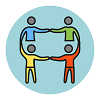Physical abuse
Physical abuse is deliberately hurting or injuring someone.
Physical abuse includes:
- assault
- rough handling
- scalding and burning
- physical punishments
- or making someone purposefully uncomfortable
It can also include inappropriate or unlawful use of restraint, or unauthorised use of restrain such as restricting movement.
Restraint might be used in some circumstances if it is part of a care plan agreed by everyone if the person lacks the capacity to consent, but is acting in a way that may cause harm to themselves or others.
In these cases restraint should only be used if it is in the person’s best interests and should be the least restrictive option.
Involuntary isolation or confinement, misuse of medication (such as over-sedation), or forcible feeding or withholding food can also be examples of physical abuse.
Signs that someone could be experiencing physical abuse include:
- unexplained injuries or inconsistency with the account of what happened
- bruising, cuts, welts, burns and/or marks on the body or loss of hair in clumps
- frequent injuries
- unexplained falls
- subdued or changed behaviour in the presence of a particular person
- signs of malnutrition
- failure to seek medical treatment or frequent changes of GP
